Text
The End?
Hello, readers. During the two and a half years White-Glove Grindhouse has been active, I’ve written twenty-eight reviews. I’ve seen a lot of great films, and a lot of terrible ones, but the journey has been a great deal of fun. However, I don’t believe that this small tumblr is the best place to showcase and grow my film criticism anymore. Therefore, on July 10, 2016, I’ve decided to shut down White-Glove Grindhouse.
But, while this may be the end of one blog, it marks the start of another. Trust me, I don’t intend to stop writing reviews anytime soon! My work can now be found at its new home, my new Medium publication The Flicker. This new online home will hopefully be able to attract new readers and present my writing in a smooth, professional way. I hope you continue to enjoy my reviews, no matter where they might be found.
3 notes
·
View notes
Text
REVIEW: “Finding Dory” (2016)

By Erik of White-Glove Grindhouse
Even though it was released thirteen years ago, Finding Nemo is still one of Pixar’s most unforgettable films. Given that the Pixar catalog has no shortage of iconic and successful movies, that’s quite a feat! The film’s breakout star, a forgetful Pacific regal blue tang named Dory, has become a beloved figure to those who grew up watching her and Marlin journey through the ocean in search of Nemo. Ellen DeGeneres, who played Dory, was clearly as enamored with her character as the rest of us, and she’s often since expressed a desire to return for a sequel. Her persistence has paid off; Dory has her own movie and the rest of us have the chance to revisit a childhood favorite.
While Finding Nemo focused on the literal quest to find Nemo, Finding Dory is a more introspective journey. Struck with a sudden memory of her parents, Dory sets off with Marlin (Albert Brooks) and Nemo (Hayden Rolence) to track them down. The three of them end up at the Morro Bay Marine Life Institute, where Dory must piece together her past in a struggle against her chronic short-term memory loss. Fortunately, she has the help of Hank (Ed O’Neill), a cantankerous septopus (he lost a tentacle), as well as a nearsighted whale shark named Destiny (Kaitlin Olson), and Bailey (Ty Burrell), a deeply self-conscious beluga whale.

These new characters help set the film apart from its predecessor. Gill might have put it best in Finding Nemo: “Fish aren’t meant to be kept in a box, kid. It does things to you.” Dory’s new companions all suffer from neuroses and insecurities, and their charming quirks make them compelling and endearing as characters. The fact that all of them are played by fantastic comedic actors only sweetens the deal. Hearing these familiar voices play off each other is immensely entertaining in its own right, and through them we come to appreciate the unique atmosphere of the Marine Life Institute.
Indeed, the majority of the film is set at the Institute, which is jarring in contrast to the vast, oceanic scale of the first film. However, while Nemo was told in the style of an epic journey or a road movie, Finding Dory is more akin to a detective story. Where it differs from other mysteries is that the clues are already all in the protagonist’s head, waiting to be unearthed. Of course, when the head in question is Dory’s, discovering those clues is no easy process. Still, she is determined, and in her own addled, brilliant way, Dory begins to find answers to the questions she didn’t even know she was asking in the first place.

Though she often served as comic relief in the first film, Dory proves herself more than capable of taking on a lead role. Now that she’s front and center, it’s impossible not to see the detriments of Dory’s chronic short-term memory loss. Those around her, despite their best intentions, often have little patience for her challenges and don’t spare her much sympathy. What’s so brilliant about Dory is that her genuine, good nature can’t help but outweigh her challenges. Thanks to DeGeneres’s buoyant, affable performance, this little blue fish is a tremendous joy to be around. Her differences, tough as they are to manage, are far from the sum total of who Dory is. Watching her fight to reconnect with her family in spite of her disability makes this sequel far from a retread and quite moving in its own right.
It may not be quite as breathtaking or as sharply witty as its predecessor, or cover quite as many miles, but Finding Dory is still one of the best Pixar sequels to date. The film’s colorful characters and intelligent story make it both engaging and meaningful for viewers of any age. DeGeneres’s performance is a satisfying homecoming for all those who grew up with Nemo, and she’s supported by a bevy of comedic talent which helps give new life to the series. Is Finding Dory destined to be a classic in the Pixar echelon? It’s hard to tell this early out, but as it stands now it’s a worthy follow-up to the original and a fantastic excuse to revisit some old friends from the deep blue.
Final Score: 8.5/10

For more film review and essays, check out White-Glove Grindhouse!
#Finding Nemo#Finding Dory#Pixar#Disney#ellen degeneres#albert brooks#ty burrell#kaitlin olson#ed o'neill#mystery#animation#animated#sequel#2016#idris elba
5 notes
·
View notes
Text
REVIEW: “Too Late” (2015)

By Erik of White-Glove Grindhouse
For any filmmaker, there’s a fine line between taking inspiration from directors you admire and just plain imitating them. Too Late crosses it. It’s not much of a stretch to gather that first-time feature director Dennis Hauck wanted badly to make a Quentin Tarantino movie. Of course, he’s hardly the first indie filmmaker to have his particular ambition, but he takes it further than most would. Hauck’s debut film is a crime story told in a non-linear fashion, filled with long stretches of stylized, snappy dialogue. It even uses Tarantino’s usual credits font for its opening and closing titles! To anyone paying attention, the similarities are clear. That said, a good film is still a good film, no matter what other good films it might happen to resemble. Does Too Late have what it takes to be elevated above the status of a mere imitator?
At times it does, and much of that is due to the committed performance of its lead, John Hawkes. Hawkes stars as Sampson, a California private eye as earnest as he is troubled. The film begins with the murder of a young, beautiful stripper named Dorothy (Crystal Reed). Sampson met Dorothy only once, years back, but she’d always stuck in his mind. The film jumps around in time to various crucial scenes in Sampson’s life, some before Dorothy’s murder and some after. In one, Sampson confronts two gangsters (Robert Forster and Jeff Fahey) after drunkenly crashing his car. In another, he meets a former partner (Dichen Lachman) at a combination drive-in movie theater and open-air fight ring. Each of the five scenes is presented in one long, unbroken take.

This particular artistic device, the use of the long take, is one of the most effective in the film. Some of the lengthy dialogue scenes would have benefited from being cut down a tad, but for the most part each scene is constructed in a way that gradually engulfs the audience in the conflict. Choosing to tell this story though unbroken shots speaks to Hauck’s integrity as a director, considering he also made the decision to shoot on film. If he’d shot digitally, the camera could roll for hours with a big enough hard drive attached, but film is finite, not to mention expensive. Bill Fernandez’s gorgeous cinematography makes the extra money spent more than worthwhile; the colors in this film are bold and stunning, from the bright red of Dorothy’s sweatshirt in the opening scene to the haunting blue and purple glow of the strip club’s lights.
The film’s dialogue tries to sparkle to the same degree, attempting to find a middle ground between old-Hollywood wordplay and Tarantino-esque rapid-fire torrents of words. It doesn’t accomplish either to a convincing degree, though not for lack of trying. Many of the film’s five core scenes are driven by dialogue, which is a creative choice that can work if the writing is especially sharp and engaging, but without much else in the film to focus on each forced pop culture reference or shaky bit of repartee feels especially glaring. There are a few lines in particular that feel vulgar for vulgarity’s sake rather than for any real storytelling reason. This flaw isn’t limited to the dialogue, either—in the second scene, a major female character spends the majority of her time on-screen naked from the waist down. Why? A fair question, but Hauck doesn’t provide any compelling answer to it.
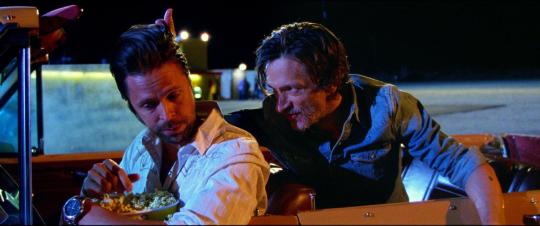
It’s a genuine shame because, despite its unsuccessful attempts to be stylish, Too Late has some real heart. The central story that unfolds is as tragic as it is engaging. It’s true that crime films centered on the emotional insecurities of a male private eye are commonplace, but Hawkes as Sampson presents the audience with a relatable character burdened with innumerable human weaknesses. The other characters feel somewhat flimsier in comparison, but nonetheless Sampson is a compelling reason to remain invested in the film. Watching him make his uneasy way through the criminal element towards his ultimate goal is often gripping, and sometimes even moving.
A few select moments of emotional clarity don’t make for a great film on their own, of course, and this is where Too Late suffers. It uses its stylistic influences as a crutch rather than a jumping-off point towards originality. On those grounds, though it’s far from a bad film, it’s difficult to recommend. Dennis Hauck’s feature debut has plenty of things going for it, from a compelling main character to lush, striking cinematography. That said, its script is flawed and amateurish in too many ways to ignore. Hopefully Dennis Hauck’s next picture will allow him to break free from the stylistic confines of his inspirations and grow into his own personal voice. For that, at least, it’s not too late.
Final Score: 6/10

For more film reviews and essays, check out White-Glove Grindhouse!
#Film review#Movie review#2015#neo-noir#Too Late#Dennis Hauck#John Hawkes#Dichen Lachman#Crystal Reed#long take#Quentin Tarantino#crime drama#35mm#Brattle Theatre
3 notes
·
View notes
Text
REVIEW: “Hail, Caesar!” (2016)

By Erik of White-Glove Grindhouse
Watching Hail, Caesar! is a perplexing experience. The main reason it’s so frustrating is that, in most respects, the film refuses to frustrate in the slightest. Sure, writer-directors Joel and Ethan Coen have a handful of straightforward crowd-pleasers under their belts (like 2010’s True Grit), but they’ve never shied away from using their personal vision and sense of style to make unique and artistic films. The signature Coen style is abundant in Hail, Caesar!—the cast features an endless roster of returning players, and the brothers’ sense of dry wit permeates the dialogue—but their vision is strangely absent.
That’s not to say that Hail, Caesar! is an unpleasant film to watch. Far from it; it’s fun to follow Hollywood “fixer” Eddie Mannix (Josh Brolin) as he struggles to keep Capitol Pictures’s various movie productions on track and ensure its reputation is scandal-free. When up-and-coming star DeeAnna Moran (Scarlett Johansson) gets pregnant, for instance, it’s Eddie’s job to help her avoid the stigma of unmarried motherhood. When a young cowboy actor (Alden Ehrenreich) has a hard time adjusting to the world of period costume dramas, Eddie’s called in to give him guidance. Or when Baird Whitlock (George Clooney), star of the studio’s swords-and-sandals epic Hail, Caesar! all of a sudden goes missing? Yeah. Eddie has to handle that, too.

These individual moments and scenes are amusing in their own right, but they never truly build up to anything. For a Coen brothers film, this is a disconcerting experience; even in the pair’s zanier comedies (The Big Lebowski comes to mind, as do Burn After Reading and The Hudsucker Proxy), there’s an emotional core to the story that gives the audience something to hold tight to as the madness unfolds around them. The closest Hail, Caesar! has to an central struggle for its protagonist is Eddie’s temptation to leave the drama and hysterics of the movie business for a less stressful Lockheed-Martin job. This conflict, though, never carries much weight and is resolved neatly (and without much consternation on Eddie’s part) by the end of the film.
Lacking a solid emotional backbone, the film amounts to a series of funny-but-fleeting cameos and vignettes. Frances McDormand in particular pops in for a memorable scene as C.C. Calhoun, a fast-talking editor happily secluded from the rest of the studio chaos. Several scenes also show off the Coens’ pointed and hilarious satirical side, including a meeting between four squabbling religious leaders over whether or not a portrayal of Jesus in one of Capitol’s films has the potential to offend audiences. As enjoyable as these individual moments are, it’s hard to shake the feeling that the Coens are treading familiar ground. Of course, it’s impossible to make movies for as long as these two have without revisiting some moods or themes, but Hail, Caesar! doesn’t use these old ideas in service of new creative risks.

And it’s not as if this lack of innovation is endemic to the Coens’ recent work. This critic may not have liked it that much, but Inside Llewyn Davis was at least unmistakably personal—it meant something to its directors. Hail, Caesar! is a more pleasant journey from the audience’s perspective, but at the same time it’s not nearly as compelling. It often feels as if the film’s meaning is lying dormant under its surface, waiting for a single brilliant scene to bring it into view. Of course, not every single element of a story has to tie together in a neat package, but a moment of emotional clarity might help make the overall film something more than a disjointed assortment of disparate scenes.
Who knows; maybe the lack of storytelling focus was the point. If it was, though, it doesn’t seem like a point much worth making. Whatever the case, Hail, Caesar! isn’t an especially bad movie, but coming from two of the most brilliant writer-directors working today it feels sadly routine. As a Coen brothers film, it’s a frustrating paradox. In many ways, it’s far too much of the Coens in one package, but at the same time it doesn’t offer nearly enough of what makes them great filmmakers in the first place.
Final Score: 5/10

For more film reviews and essays, check out White-Glove Grindhouse!
#Coen brothers#Joel Coen#Ethan Coen#Hail Caesar!#Josh Brolin#George Clooney#alden ehrenreich#Scarlett Johansson#film review#movie review#film criticism#Hollywood#movies about movies
2 notes
·
View notes
Text
REVIEW: “Zootopia” (2016)

By Erik of White-Glove Grindhouse
Take cover, everyone. Batten down the hatches, and pack away the good china. It’s time for crisis mode: Disney’s back, and this time it’s self-aware!
Well, technically Zootopia is the second film in what I’ve begun to call Disney’s “post-pixie-dust” period. The first was 2013’s smash hit Frozen, in which Princess Anna gets engaged to Prince Hans within an hour or so of meeting him. Now, in the old days, that might have been Happily Ever After, but within the film itself several characters correctly point out that actual love doesn’t just spring into full bloom in an afternoon. Not only did Disney subvert the storytelling traditions they’ve stuck to in the past, they actually acknowledged that their fairy tales might have set some unrealistic expectations.
Zootopia takes a similar approach in telling its story. Its message is that old family movie chestnut, “follow your dreams,” but it openly points out that, even with a substantial helping of determination and elbow grease, the world might not welcome your dream with open arms. In fact, it might fight you every step of the way, it might even slam doors in your face. And the reason for these challenges may be something as frustratingly arbitrary or immutable as the way you look or the cultural background you come from.

Which isn’t to say that Zootopia is out to slap kids in the face with reality. It delivers its message by telling a fun caper of a story in a vivid setting: a diverse world populated with humanlike animals, where predator and prey live in harmony. Our guide through this world is Judy Hopps (Ginnifer Goodwin), the first rabbit officer (or, shall we say… bunny cop?) accepted into the Zootopia Police Department. She travels to the big city, full of gumption and packing a can of fox repellent (the latter thanks to her well-meaning if sheltered parents) but finds herself assigned to give out parking tickets on her first day at work. So much for making the world a better place. Judy soon crosses paths with Nick Wilde (Jason Bateman), a wily fox of a con man (literally and figuratively) with whom she forms an unlikely crime-solving duo.
Sounds like an exciting romp through a colorful animated city with a heaping helping of animal puns thrown in, right? Well, it is all that, make no mistake, but Zootopia also has the ambition to use its family-film trappings in order to deliver some social commentary. Even though predators in the world of Zootopia no longer eat prey to survive, many of the prey aren’t able to shake their deeply-held, fearful preconceptions of them. Though Nick and Judy are initially at odds, they soon find that they’re both victims of this sort of prejudice. Since Judy’s a bunny, everyone assumes she’s not capable of being more than cute and fluffy. Likewise, when people encounter Nick, they automatically expect him to be untrustworthy and, well… foxy.

In worse movies this stand-in for racial profiling would seem obvious and forced, but in Zootopia it’s remarkably organic. This element of realism makes the animal characters even more humanlike; not only do they walk, talk, and wear clothes like we do, but they’re also lifted up by similar hopes and struck with the same fears. Like last year’s Pixar masterwork Inside Out, Zootopia does its young audience a remarkable service simply by not talking down to them. It recognizes that the world is not a perfect place and that everyone is capable of misjudging those around us, but also reminds us that recognizing our mistakes is a necessary step towards self-improvement. Fear can be a powerful and destructive force, but seeking greater understanding is a necessary step if we want to be free from its influence.
Fortunately, apart from its social commentary, Zootopia is a great deal of fun. Judy and Nick make a terrific buddy cop duo, and it’s a treat to watch them match wits and one-up each other over the course of the film. Goodwin and Bateman do plenty to bring the hilarious script to life, and they’re bolstered by a supporting cast of skillful performers, of which Idris Elba, Bonnie Hunt, J.K. Simmons, and Shakira are just a few. Equal parts entertaining and meaningful, Zootopia is a delight of a movie. If this is the end result, Disney ought to poke fun of themselves more often.
Final Score: 8/10

For more film reviews and essays, check out White-Glove Grindhouse!
#Disney#Film Review#Ginnifer Goodwin#Jason Bateman#Idris Elba#movie review#racism#family movie#animated#police
5 notes
·
View notes
Text
Celluloid Spelunker #1: “Detroit 9000″ (1973)

By Erik of White-Glove Grindhouse
Hey, readers, it’s Erik, your resident Celluloid Spelunker. What’s a Celluloid Spelunker, you ask? Fair question, especially considering this is the first time I’ve ever written the term myself. The Celluloid Spelunker is a new column on White-Glove Grindhouse where I pick a film, entirely at random, that is available on one of the many online movie streaming services that cinema fans have access to. Then, I’ll give it a watch!
The vast movie catalog of these sites (which shall remain nameless until one of them decides to sponsor me) can be daunting to even the most experienced cinephile. There’s simply so much to pick from that it’s hard not to wonder what hidden gems might be lurking in the dark corners of cyberspace. With this column, I intend to illuminate those corners--at least a few of them, anyway. The objective being to help you, my faithful reader, determine whether or not each specific film I tackle is worth your time.
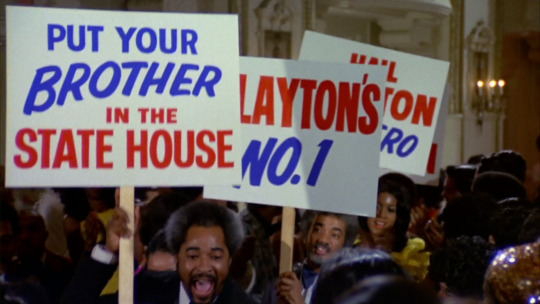
Out of the five random titles I selected this time around, Detroit 9000 seemed the most promising. Given the number in the title and the bright, evocative poster listed online, I was curious for a moment as to whether this was some sort of far-future science fiction tale. Then, I saw the release date: 1973. So, the bizarre poster can be chalked up to the seventies, but what about the title? Well, as I found out, through the film itself and some further research, “9000” was the police code at the time which meant “officer down.”
With that factoid in mind, the title proves to be remarkably fitting. Detroit 9000 is something of a Blaxploitation cult classic, a cops-and-robbers tale that delves deep into the moral, political, and racial morass of its titular city. As rising black politician Aubrey Hale Clayton announces his candidacy for Governor of Michigan, his fundraising gala is hit by a tightly-orchestrated group of thieves. As the police and press alike struggle to determine whether or not the robbery was a simple theft or a racially-motivated hate crime (the robbers wore full-body coverings, making their own racial identity indeterminate) two cops band together to bring the culprits to justice.

Part of what makes Detroit 9000 so notable is that it’s one of the earliest mixed-race buddy cop movies. White detective Danny Bassett (Alex Rocco) has to somehow mesh his brash, rough-around the edges investigative style with that of the refined, educated black cop, Sergeant Jesse Williams (Hari Rhodes). Though they respect each other and work well together, each realizes that the other man’s desire for glory and recognition could be a source of trouble down the line. By not relying on straightforward racial animosity to fuel conflict between the two, the film allows the characters to be rich and complicated in their own right.
In fact, the film’s strongest aspect by far is its characters. For a crime film in a genre known for broad character archetypes such as the smooth, womanizing Shaft, Detroit 9000 doesn’t rely on easy clichés when defining its characters, be they black or white. Danny Bassett’s wife is an unstable invalid he longs to be rid of, but even as he sleeps around with prostitutes he feels a creeping sense of obligation to her. Though Clayton is perhaps the best political hope for the black citizens of Detroit, in private he’s something of a sleazy businessman who is also a regular patron of the city’s brothels. Speaking of the prostitutes, they’re led by a wise, kind madam who strictly enforces racial integration among her clients and staff. Detroit 9000, though it is absolutely a crime b-movie in many ways, also managed to keep me guessing as to what unique personality would be introduced next.

The downside of Detroit 9000’s B-movie status is that it absolutely feels like a B-movie. While this aesthetic is often charming, it also leads to some repetitive action and chase scenes that bog down the more enjoyable aspects of the film. Despite the nuances of its characters and the subtle complexity of the unfolding investigation, the climax is a cops-and-robbers bloodbath that’s both soulless and, by the end, pretty dull. In the world of Detroit 9000, the solution to every problem is a bullet in the gut. Yes, we get a certain visceral thrill from watching the bad guys get blasted into red goo, but such a brainless finale undermines the compelling subtleties of the rest of the film.
Well, I’d say for a first venture into the cinematic darkness that one went pretty well. To be honest, I’d hoped to be able to introduce this column with a pile of celluloid garbage so that I could lay the snark on thick from the get-go, but it was not to be! Who’d have thought that, so early on, I’d be lucky enough to find a diamond in the rough? Despite its flaws, Detroit 9000 is well worth a viewing for those who enjoy the occasional cult classic. After some post-viewing research, I found that not only has the film attained cult status, it’s a favorite of Quentin Tarantino, who gave it a theatrical re-release in 1998! Imperfect as it is, I thoroughly enjoyed my time with it. Detroit 9000 is RECOMMENDED.
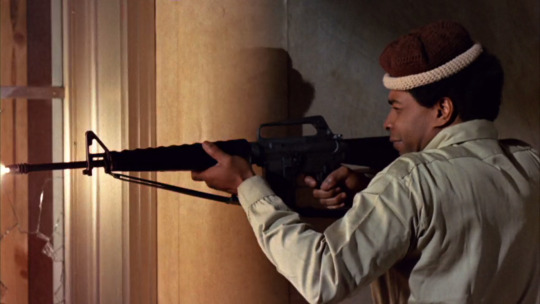
For more film reviews and essays, check out White-Glove Grindhouse!
#Celluloid Spelunker#Detroit 9000#blaxploitation#crime drama#movie reivew#film review#buddy cop#exploitation#Quentin Tarantino#classic#1970s#black power
0 notes
Text
REVIEW: “Deadpool” (2016)

By Erik of White-Glove Grindhouse
As enjoyable as superhero movies are, let’s face it: they take themselves too seriously from time to time. That’s why a character like Deadpool is, for many comic book fans, so refreshing. He’s an utter maniac; a goofy, foul-mouthed mercenary who talks right to the audience, happily flouting the traditions of storytelling and breaking the fourth wall. He’s also, thanks to his frequent f-bombs and sex jokes as well as a penchant for gleeful, bloody murder, firmly in R-rated territory. That would explain Marvel and Fox’s hesitation to bring the character to the big screen, having dug out a comfortable PG-13 niche for themselves over the years. They may be rethinking that strategy now, as Deadpool’s debut film has been released, it’s rated R, and it’s a massive hit. But is all that creative freedom used to its fullest potential?
What, you really didn’t think I’d tell you right at the beginning, did you? Come on, you’ve got to keep reading for that. Yes, I know, it’s a lot of text on tumblr, I’m so sorry. You’ll get back to your gifs of sassy Tina Belcher in a minute or two, let me get through a few more paragraphs. Ok? Here, I’ll summarize the plot in the next one so you don’t have to watch the trailer. It gives away all the best jokes anyways.
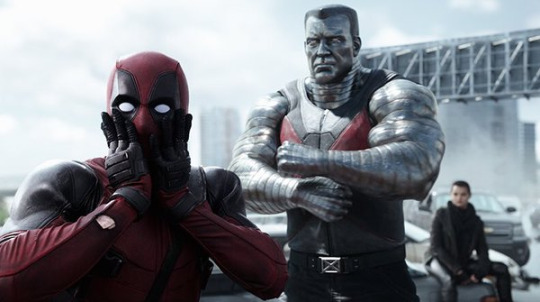
Hired gun Wade Wilson (Ryan Reynolds) has a damn good life. Not only is he a mercenary at the top of his game, he’s engaged to Vanessa (Morena Baccarin), a beautiful prostitute who’s just as crude and sharp-witted as he is. Of course, cancer, as it tends to do, steps in to drop a steaming turd all over everything. Left with a terminal diagnosis, Wade takes a chance on an experimental mutation therapy, but the procedure goes awry and works Wade’s face over with the proverbial ugly stick. Now horrendously scarred and left with little more than his sense of humor, Wade sets out to get revenge and regain his People Magazine’s Sexiest Man Alive good looks.
The quest for vengeance that ensues is enjoyably goofy, with Deadpool continually indulging his inner (and outer) psychopath while a pair of X-Men, Colossus and Negasonic Teenage Warhead, try to drag him back to some semblance of good. Best of luck to them; unlike Batman and his no-gun policy, Deadpool aches to dispatch his foes in a torrent of bullets and blood, and the film doesn’t hold back when he finally gets the chance to. Reynolds is obviously having the time of his life playing the “Merc with a Mouth,” relishing in the character’s vulgar nature while still giving him plenty of charisma. Thanks in no small part to his performance, Deadpool is a fun, buoyant romp rather than a grisly slog. It’s hard to imagine anyone else embodying Deadpool so well.
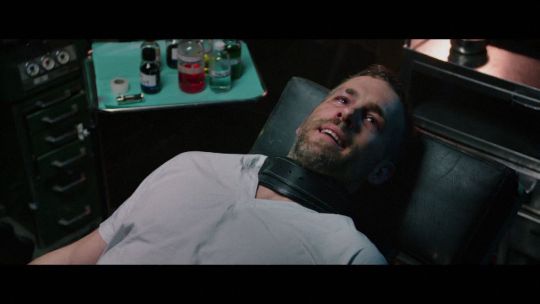
Though Reynolds certainly expresses the subversive spirit of the character, Deadpool as a film has some catching up to do in that department. Yes, the action is bloodier here than in most Marvel films, the dialogue is cruder, the nudity… exists. But, apart from a few lighthearted jabs at the X-Men film series and some of the clichés that persistently show up in superhero movies, Deadpool isn’t especially bold or groundbreaking. It follows the same general story formula that most Marvel movies do, with the main difference being that the one pointing out the overused tropes is the protagonist, not some bitter critic ranting about it on his blog that no-one reads. It may have the freedom to go further and do more content-wise than the average superhero film, but Deadpool takes fewer actual creative risks than, for instance, James Gunn’s wickedly inventive Guardians of the Galaxy.
I feel as if I’m being torn in two different directions with this one. On one hand, Deadpool isn’t a terrific film. It’s good, but definitely not great. Maybe the whole gambit (ha ha ha) of self-referential humor is just not that compelling to me, or perhaps it wasn’t used as well as it could have been in this case. On the other, as a moviegoer and a fan of superhero films, it’s heartening to see that not only did something like Deadpool get made in the first place, it’s also making a crap-ton of money! It may not have elevated the comic book film to new creative heights, but at least Deadpool has shown the studios that audiences will come out in droves to see something different. For delivering that message alone, I salute thee, O Merc with a Mouth. Kudos.
Final Score: 6.5/10

For more movie reviews, check out White-Glove Grindhouse!
#Deadpool#Marvel#Ryan Reynolds#Superhero#x-men#bob's belchers#tina belcher#colossus#negasonic teenage warhead#sony#film review#breaking the fourth wall#wacky jokez#movie review
2 notes
·
View notes
Text
REVIEW: “The Revenant” (2015)

By Erik of White-Glove Grindhouse
At first glance, it seems that The Revenant could hardly be more different from Alejandro González Iñárritu’s last film, the Best Picture Oscar-winning Birdman. Having told the story of a washed-up blockbuster actor struggling to resuscitate his career, the director has now turned his sights on the real-life story of Hugh Glass, a fur trapper who struggled his way back to civilization after being mauled by a grizzly bear. Different though it may be in subject matter, Iñárritu infuses The Revenant with the same sense of poetry and grace that helped define Birdman, while at the same time refusing to hold back during the film’s most brutal moments. It won’t suit all tastes, but Glass’s grueling odyssey is nonetheless a moving and personal work of cinema.
Hugh Glass (Leonardo DiCaprio) lies half-buried in a shallow grave. John Fitzgerald (Tom Hardy), consumed by his greed and hatred, murders Glass’s Native American son and tricks the young Bridger (Will Poulter) into taking the man’s equipment and leaving him to die. Despite his grievous wounds, Glass continues to draw breath. He hauls himself out of the grave, fighting the elements as well as the cruel nature of man to track down Fitzgerald and avenge his son. All the while, he is haunted by visions of his dead wife (Grace Dove) and hounded by a band of Arikara Native Americans on a dire quest of their own.

As intense and powerful as DiCaprio’s central performance as Hugh Glass is (and, make no mistake, it is powerful; his recent Oscar win as Best Actor is well-deserved), the true star of The Revenant might be its vast, untamed setting. The spectacular cinematography by Emmanuel Lubezki captures the dense forests and snow-covered plains in all of their gorgeous, fearsome grandeur. This unadulterated natural world is a startling sight, not only because of its unforgiving qualities but also due to how rare such raw splendor seems to be in the modern world. It’s genuinely reassuring to see that places like these survive today and that, however uncommon, the sort of wilderness Hugh Glass grapples with can still be witnessed by human eyes.
On the topic of the wilderness, The Revenant portrays the dangers of the frontier in a way that’s beyond refreshing. Most films, especially American ones, present the wilderness as dangerous, to be sure, but also as something to be conquered by rugged individuals. Iñárritu’s view of the frontier, on the other hand, seems far more nuanced and realistic. The group of trappers Glass sets out with are no more civilized than the bands of Native Americans they struggle against, and death comes easily to both sides. The Revenant, then, is a sort of anti-Western, pushing aside the myth of a fair, orderly universe in favor of a more nihilistic worldview. Glass’s fragile humanity is both beaten down and elevated to new heights in this harsh climate.

The sense of elegance Iñárritu tempers his film with does help to make its agonies more bearable. Moviegoers hoping for a traditional adventure yarn are likely to be disappointed, as the film has little concern for the usual standards of structure and pacing. The Revenant feels, if anything, like an epic poem brought to life on-screen. It may defy some of the typical conventions of film storytelling, but Iñárritu’s artistic command of his medium allows him to break these rules with purpose. On occasion, the film’s more arty qualities distance the viewer from the human element of the story, but more often than not the balance of pain and poetry is handled with remarkable skill.
The Revenant is another remarkable film by one of cinema’s most visionary directors working today. Every frame of Alejandro González Iñárritu’s film speaks to the strife and difficulty of its production, and the end product is both intensely beautiful and achingly true. As a movie, it’s not likely to be a crowd-pleaser--those who don’t wish to see a horse carcass gutted on-screen, consider yourselves advised to sit this one out. For the adventurous, though, The Revenant offers an arduous journey that is well worth experiencing. Whoever dares to venture into its grim, dangerous, chilling, resplendent world is not likely to leave unaffected.
Final Score: 8.5/10

For more film reviews and essays, check out White-Glove Grindhouse!
#leonardo dicaprio#academy awards#best actor#oscar#alejandro gonzález iñárritu#birdman#tom hardy#the revenant#drama#adventure#movie review#hugh glass#the dollop#bear#bear attack
2 notes
·
View notes
Text
“It’s Just Business”: The Criminal Professionals of “The Killing” (1956)

By Erik of White-Glove Grindhouse
In Hollywood, crime is romance. Gangsters live large, enjoying life’s finest and most sensual pleasures (women, clothes, food, drugs--the works), to say nothing of the general lust for power and influence that drives them. From Henry Hill to Michael Corleone, these celluloid hustlers play a thrilling game of chicken, daring the law to take them on and send their devil-may-care lives into freefall. Nearly every time, the gangsters lose that game, doomed by their own greed and arrogance. The law wins, and order is restored.
Stanley Kubrick’s first full-length feature, The Killing, is no different in that regard. As the final frames flicker across the screen, the audience is placed into the perspective of Johnny Clay (Sterling Hayden) as the cops advance on him, guns drawn, preparing to throw him back in prison for his daring holdup of a racetrack. At first glance, Clay’s story seems just like any other crime-doesn’t-pay cautionary tale, but there’s one crucial difference. Plenty of screen gangsters claim that their illicit activities are just a job, a purely practical way to make ends meet, but when Clay gives that same rationale it’s actually believable. By stripping his heist film of starry-eyed romantics, Kubrick challenges us to consider screen crime in a chilling new way.
For instance, unlike in other crime films, the immorality of the central heist is never questioned. It’s taken completely for granted that these men are committing a crime, and nobody ever tries to claim that it’s a victimless one. They’re not robbing a corrupt bank or getting back at an old enemy. They simply see a viable target with exploitable weaknesses (a racetrack which several of the men work for) and decide to take as much as they can from it. Simple as that. The decision is made rationally, with the formality of a crisp handshake. No vendetta, no unconquerable urge to rebel against the drudgery of daily life. No desire to do bad for bad’s sake. These people simply have less money than they’d like to have, so they take steps to, as The Shining’s ghostly butler Delbert Grady might put it, “correct” that lack.

From a story standpoint, this exclusion of emotion is an odd creative choice, as most writers want their characters to be as emotionally involved in the drama that ensues as possible. It certainly wouldn’t be the first time Stanley Kubrick has been accused of being a cold, detached storyteller (most likely by those who haven’t seen Barry Lyndon, but that’s a digression for another time). With that in mind, it’s worth pointing out that these characters aren’t stiff cardboard cutouts; in particular, their leader, Johnny Clay, is an unconventional master thief. He’s respectful and courteous almost to a fault, even with the airline clerks whose baggage restrictions threaten to topple his entire enterprise. He’s the sort of man we come into contact with almost every day. Whatever personality quirks each of these robbers might possess, they’re not defined by their profession any more than a 9-to-5 cubicle dweller is defined by theirs. Their normalcy is downright jarring, especially considering the flamboyant movie criminals cinema-goers have grown accustomed to.
Sterling Hayden’s matter-of-fact performance is worthy of discussion, as in a way it sums up the emotional candor of the movie as a whole. He delivers his heist pitch in a machine-gun rapid torrent of words, roping in accomplices with worryingly easy precision. Even just observing him as a viewer, it’s hard not to be swayed by his arguments. He makes crime seem normal, inevitable; he doesn’t leave even a tiny gap of silence in which doubt could take root. For contrast, look at Hayden’s other performance in a Kubrick film as the insane anti-communist General Jack D. Ripper in Dr. Strangelove. While Clay is a smooth, swift pitchman, Ripper is a rock. In the latter role, Hayden’s more evenly paced delivery gives his words a certain authority. He won’t be convinced by the frantic protestations of Mandrake (Peter Sellers) or anyone else who would undermine his fatalistic plan. Ironically, Johnny Clay lives the more capitalistic lifestyle of the two. He’s a detached criminal entrepreneur, eager to find the next big score and not particularly concerned with anyone who might get trampled in the process.

However, as different as Clay might be from the average movie gangster, his story ends the same way. The profits of his exactingly planned heist are taken away from him in an instant, as is his freedom. Where his path diverges from other film criminals is that Clay’s downfall is largely accidental rather than a direct result of his own failings. When the bag containing all his money is accidentally knocked over on its way to the plane, its contents fly open. Dollar bills scatter like snowflakes in a windstorm as Clay’s hopes of a big score dissipate. The moment is strangely heartbreaking. Perhaps it’s because the sting of sudden disappointment is so universal, but it seems only natural for the audience to want Clay to “get away with it.” As a character, he’s free of the usual arrogance and self-importance screen gangsters are generally full of, and consequently such an abrupt, random resolution feels almost unjust.
Maybe that’s because, for better or worse, Johnny Clay is one of us. He endures the same struggles we do, always grasping for a better life and trying to move past the mistakes he made previously. Though Kubrick’s heist drama might be less glitzy than other Hollywood treatments of crime, the director’s insistence on presenting Clay and his fellow criminals as every-men makes The Killing compelling in an uncommon way. At the same time, by blurring the distinction between professional and criminal, the film prompts us to look at crime itself in a different light. Can a person’s bad deeds be reconciled with their respectable or even admirable qualities? How difficult or far-fetched would it be for any of us to become Johnny Clay? Kubrick’s film can only take us so far in this regard. The answer, if there is an answer, must be found by each moviegoer alone.
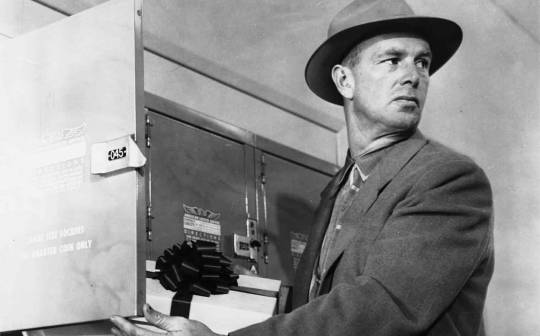
For reviews of current and classic films and other essays, go to White-Glove Grindhouse!
#The Killing#Stanley Kubrick#Kubrick#sterling hayden#Hayden#crime#noir#film noir#movie review#film criticism#essay#classic
1 note
·
View note
Text
REVIEW: “Chi-Raq” (2015)

By Erik of White-Glove Grindhouse
Chi-Raq is an intensely relevant film. That may sound like an apology or an excuse, but it’s not meant as one. Yes, Spike Lee’s latest movie has its ripped-from-the-headlines moments, referencing the killings of Tamir Rice, Eric Holder, and Trayvon Martin (just to name a few from a tragically long list) as well as the Black Lives Matter movement, but it’s so much more than a simple reflection of our times. It’s both tragic and hilarious. It’s an indictment and a celebration of the black community. It’s a daring artistic statement that few other filmmakers would even attempt to make. Most of all, perhaps, it tells an unwaveringly human story that will give anyone of any race, color, or creed something to chew on.
Chi-Raq opens with red block letters flashing before our eyes: THIS IS AN EMERGENCY. The emergency, we come to learn, is that the murder rate in Chicago tops the number of American deaths in the War in Afghanistan over the same timespan. Chicago resident Lysistrata (Teyonah Parris) realizes she’s living in the midst of a veritable war zone. She loves her boyfriend Chi-Raq (Nick Cannon), leader of the Spartans gang, but after the accidental killing of a local child she sees how destructive and dangerous his lifestyle really is. Led by Lysistrata, the women of the Spartans and the rival Trojans gang alike band together to withhold sex from their men until the fighting stops.

If some of that plot sounds familiar, you might be a fan of ancient Greek comedies. Chi-Raq is based roughly on Lysistrata, by the playwright Aristophanes, in which the ladies of Athens withhold sex from their lovers to make them stop fighting the Peloponnesian War. Embracing its roots, much of Chi-Raq’s dialogue is written in verse, with colorful narration by Samuel L. Jackson as one-man Greek chorus Dolmedes. (Among other things, he describes Lysistrata as having “a mind like Einstein and a truly luscious behind.”) The slang-filled street poetry conversations are tough to get accustomed to at first, and occasionally they do feel a little clunky, but the actors commit to the unusual style in earnest and give it the air of truth.
The cast itself is one of the film’s greatest strengths. Bringing a legendary character like Lysistrata to life is no small task, but Teyonah Parris does the job with skill and grace. Her Lysistrata is smart, kind, and ambitious. She aches to help save her people but isn’t sure she has the power to do so. As she declares war against violence itself, we see her transform before our eyes into a courageous crusader. It’s a thrill to witness. Parris gives you the feeling that, given the right mix of courage, compassion, and pure gumption, every woman has the potential to be a Lysistrata.
Also impressive is Nick Cannon as rapper/gang leader Chi-Raq. In other hands the character could easily be a one-note “gangsta” caricature, but writers Kevin Willmot and Lee make sure to reveal the inner conflict and tragedy that continually haunt the man. Cannon provides an intimate look at both the tough exterior and the tender core of suffering the character endures. The cast is rounded out by a skilled ensemble, with standouts like Angela Bassett as the iron-willed, book-smart Miss Helen and John Cusack as a growling, passionate Catholic priest.

Apart from a few odd editing choices, the film’s visual presentation is another standout. Bright purple and bright orange, the gang colors of the Spartans and Trojans respectively, dominate the frame, highlighting how different and similar the organizations are. Costume-wise, the film is endlessly inventive, from the ruby-studded eyepatch worn by Cyclops, the Trojans’ leader, to the striking camo uniforms donned by Lysistrata and the women as they wage sexual war. To top it off, Amazon’s superb technical presentation as well as the gorgeous cinematography by Matthew Libatique add up to a terrific home viewing experience.
None of this is to say that Chi-Raq is perfect. On the contrary, its glorious imperfection is part of what makes it so compelling. It’s a movie that’s unafraid to be radical, crude, and unique; the fact that so many of its creative choices actually work is a testament to Spike Lee’s talent as a director. Proving again that sharp words and razor wit can be some of the most powerful weapons against the iniquity and madness that surrounds us, Chi-Raq is a sublime call to action. We need to stop the violence, it urges us, and we have the power to do it. A warm, courageous heart beats under its acid tongue.
Final Score: 9/10
For more movie reviews, check out White-Glove Grindhouse!

#Chi-Raq#Spike Lee#Lysistrata#Aristophanes#Teyonah Parris#Nick Cannon#Samuel L Jackson#activism#shootings#Black Lives Matter#film#movie review#film review#Amazon#A Spike Lee Joint
0 notes
Photo

Metropolis Vintage german movie poster
via mmimageslarge.moviemail-online.co.uk
183 notes
·
View notes
Photo

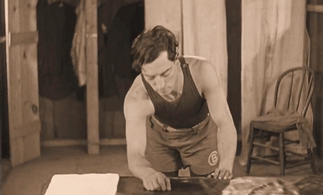


Buster Keaton is exhausted after his rather frightening boxing lesson in Battling Butler (1926)
2K notes
·
View notes
Text
REVIEW: “Tusk” (2014)

By Erik Nikander of White-Glove Grindhouse
Imagine you’re hanging out, smoking weed with your buddies. Even if that’s not your thing, bear with me for a second. You start riffing, stream of consciousness, coming up with all sort of bizarre movie ideas that are making you giggle like fiends. “What about this,” you postulate, “okay, so, there’s this guy who gets kidnapped by some creepy old dude, right? And the dude starts turning him into a walrus. Like, cuts his legs off, puts him in some sort of flesh suit, sticks big tusks in his face… and the guy loses it. He, like, he becomes the walrus. Wouldn’t that be friggin’ wild?”
Now imagine that scenario again, except you’re Clerks director Kevin Smith. And then you make the movie.
With a few liberties taken, that situation is remarkably close to the actual way Tusk was conceived. Based to a point on a bizarre internet posting he’d found, Smith jovially rattled off the film’s basic arc on an episode of his SModcast podcast, laughing his ass off all the while at its absurdity. In the film itself, he even cites the SModcast episode in the end credits and plays a segment of it as the credits roll. But the question remains: does an idea conjured up for a laugh in a marijuana haze make for a compelling feature film? If Tusk is any indication, probably not.

Wallace Bryton (Justin Long) and Teddy Craft (Haley Joel Osment) are co-hosts of the Not-See Party (Sound it out. Ha ha ha. The movie makes sure you get the joke, don’t worry.), a podcast dedicated to interviewing oddballs, weirdos, and other curious human specimens. On a trip up to Canada, Wallace sees a note in a bar bathroom that lures him to the lonely mansion of Howard Howe, an old man who has a twisted obsession with the mighty walrus.
Tusk is billed as a horror-comedy, but in truth it’s closer to a ninety-minute identity crisis. Unlike the best horror-comedies, in which the horror and comedic elements elevate each other, here they’re battling for supremacy, each gouging at the other’s throat and eyes as often as possible. The scary moments make the film far less funny, and the attempts at humor are so goofy and mishandled that any feeling of menace is dispersed before it has any time to build. There’s simply no consistency in tone. Johnny Depp’s cameo as the bumbling, cartoonish detective Guy Lapointe in particular feels like something out of an entirely different movie.

It doesn’t help that Wallace, the character we follow for most of the movie, is wholly unpleasant to be around. He’s a rude, selfish, unfaithful, exploitative dirtbag, and Justin Long’s performance doesn’t provide even a slimmer of charm to compensate for thsee off-putting qualities. Wallace does get his comeuppance at the hands of Howard, but that punishment is so sadistic that it in no way fits the crime. Haley Joel Osment as Wallace’s best buddy and podcast co-host is a lot more fun to watch, but he has nothing to do until the film’s second half.
And that’s not even getting to Howard himself. Michael Parks plays the old recluse with gleaming eyes and a sly twist in his voice, and his twisted magic is the closest the film comes to nailing the horror-comedy balance. However, Smith’s writing gets in its own way again, this time by giving Howard a traumatic backstory which he reveals over a few rambling monologues. These all feel superfluous; if there’s one character whose motivations would do better in the realm of the unknown, it’s the crazy old man trying to turn people into walruses! He doesn’t need a boring, drawn-out supervillain origin rant, and even when given one his character doesn’t seem any more realistic.
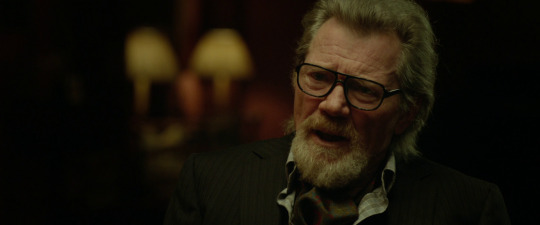
Besides, it’s not like any of these characters live in the real world. I’m not Canadian, and I’ve never been to Canada, but I doubt Kevin Smith’s Canada has much in common with the actual country. If Canadian was a race, I’d say this movie was racist, but as-is it just throws a bunch of lazy stereotypes at the audience in lieu of real jokes. Canadians love hockey! Canadians say “aboot”! It’s not exactly groundbreaking comedy.
The only remarkable thing about Tusk is that it actually got made in the first place. Beyond that, unfortunately, there’s not much to enjoy. Considering the ridiculous concept that spawned the film, the final product is surprisingly serious and grim… except when it’s not. The tone darts back and forth between The Pink Panther and Saw so frequently that it’s impossible to actually enjoy either extreme. If you’re aware that Tusk exists, you’ve already gotten the maximum amount of amusement out of it. Sadly, the film itself can only let you down from there.
Final Score: 2/10
For more movie reviews, check out White-Glove Grindhouse!
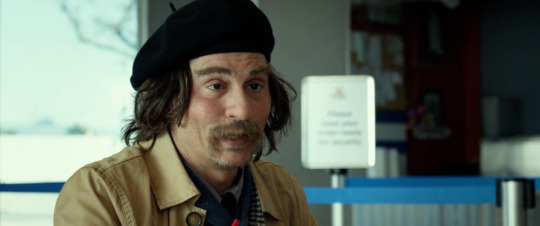
#Tusk#Movie review#film review#kevin smith#yoga hosers#johnny depp#justin long#horror#comedy#confused#why#michael parks
2 notes
·
View notes
Text
The Joy of Not Knowing
It's 11:38 PM, on Thursday, December 17, 2015. In less than twelve hours, I'll be sitting in a movie theater and watching Star Wars Episode VII: The Force Awakens. I can't say now if the movie will live up to my expectations (though critical response seems exceptionally warm), but even just the experience of waiting for this movie has been nothing short of extraordinary.
If you've seen the trailer for the average film, you might feel that you hardly need to pay to see the film in question. When the studio spells out the entire plot for you, shows the emotional high and low points and many of the best jokes, experiencing the film for the first time in theatres tends to be a limp, rote experience. Not so with the trailers and commercials for The Force Awakens. These ads didn't show much, just enough to get fans longing for more. They painted broad strokes, presented us with general images of the film's new characters without revealing exactly how their fates intertwined, saving the specifics of the film's plot to be revealed in the film itself.
Which is an uncommon thing. In the age of the internet, it's nearly impossible for anyone who keeps up with film to see a movie without having an intimate knowledge of it beforehand. Scripts leak, screener copies leak, and avid viewers spread the details to all their friends, denying them the experience of watching the film completely fresh. This is just how we experience movies today, and as viewers we've become complacent. We're okay with movies just being routine, with stripping the medium of its possibilities to deliver unexpected wonder.
This is why I give immense credit to Disney and J.J. Abrams for holding back and not giving in to the fans' well-intentioned cravings for knowledge. They realized that they don't need to reveal everything beforehand because Star Wars is a phenomenon. People will always flock to it in droves. Perhaps, then, eschewing the usual advertising strategy was a safe gamble, but it was a gamble nonetheless, and I am grateful that they stuck to their guns. This level of commitment tells me that the film isn't just an assembly-line product; its creators regard it as a powerful cinematic experience, not some cynical device which only exists to make millions of dollars.
In fact, this circumstance reminds me of a little sci-fi adventure film that came out in 1977 and became an worldwide cultural force. Moviegoers didn't know much about it beforehand, but a film that exciting and moving drew them in anyways. J.J. Abrams and crew, then, seem to be mindful of what made Star Wars so great in the first place. They want us to remember when we first experienced The Force Awakens: sitting in the theater, the lights gone dark, the opening crawl scrolling past with the John Williams theme blasting in surround sound...
And away we go.
0 notes
Text
REVIEW: “Spectre” (2015)

By Erik of White-Glove Grindhouse
If Spectre was the first James Bond film someone had ever seen, they might love it. Taken on its own, it’s a compelling spy thriller that exemplifies much of what makes the Bond series so well-known and beloved. At the other end of the audience spectrum is the longtime fan, someone who’s seen at least a decent amount of the twenty-three previous Bond films and who knows roughly what to expect. For this devotee, Spectre is a bit too familiar. It delivers an enjoyable tribute to what’s come before, but doesn’t have the nerve or the boldness to be remembered with the same fondness as the best of Bond’s adventures.
To its credit, Spectre does at least try to add something more to the established Daniel Craig Bond saga. After the death of Judi Dench’s M in Skyfall, Bond takes on a more personal mission in order to unravel one of the darkest mysteries of his past. At the same time, the new M (Ralph Fiennes) deals with a bureaucratic nightmare: a new global intelligence system that could wipe out the Double-O program altogether. With the help of Q (Ben Whishaw) and Moneypenny (Naomie Harris), Bond tracks down Dr. Madeleine Swann (Léa Seydoux), a psychologist with ties to the mysterious organization known as Spectre.
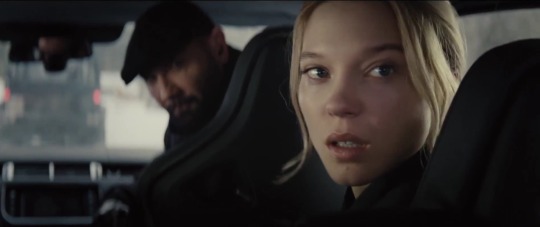
Spectre is a familiar name to anyone with a passing knowledge of the Bond franchise. It’s the vast criminal network, headed by one Ernst Stavro Blofeld, behind various large-scale terror plots which Bond must foil. Its inclusion here marks its first major appearance since 1971’s Diamonds are Forever, in what may be an effort to realign the canon of Daniel Craig’s Bond with the classic Connery films. It’s no surprise that a rebooted series would reintroduce characters and plot elements that fans are already familiar with; Star Trek Into Darkness, for example, was virtually a remake of the classic Trek film The Wrath of Khan. But like Into Darkness, Spectre relies on these familiar motifs to an unhealthy degree, seemingly to avoid the risk of trying something new.
Take the return of Blofeld, here played by Christoph Waltz, for instance. Waltz brings his brand of smooth, calculated villainy to the role, and gives a rock-solid performance. Since Blofeld is such an established figure, though, it often feels like Waltz is merely fitting into the mold; he doesn’t have the chance to cut loose a little and make the character his own. While Skyfall did reintroduce some classic Bond characters, they did so in a less cautious way. Naomie Harris as Moneypenny in particular was a refreshingly dynamic departure from the dowdy secretary pining after Bond from M’s office. Waltz’s new Blofeld is a far safer experiment.
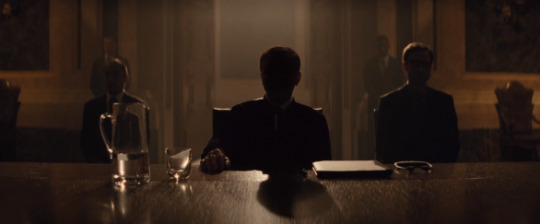
Of course, it’s not as if the film gives the character much room to breathe. He might be credited with a starring role, but Waltz is barely in the film until the end of the second act. Indeed, much of the film is devoted to M’s efforts to preserve the Double-O program, a development that frankly feels quite boring and expected compared to Bond’s personal journey. The end result is that Blofeld’s backstory and motivation receive little more than a hasty footnote’s worth of explanation, making it feel overly cartoonish and unbelievable. That such an important figure in Bond’s life is given so little development is a major missed opportunity.
Of course, not all of Spectre is a disappointment. Dr. Swann is an intelligent, capable “Bond girl,” played empathetically by Seydoux, and her character is thankfully given more space to develop than Blofeld’s. Dave Bautista plays a frightening brute of a henchman named Mr. Hinx, a welcome addition to the Bond library of memorable goons. Though Sam Smith’s theme song “Writing’s on the Wall” is no “Skyfall,” it does pack an emotional punch. Sam Mendes, once again, proves himself to be a more than capable director, as Spectre is both a compelling thriller and a visual treat. Spectre’s tendency to stick to shallow waters may not be a fatal flaw, but the next Bond film would do well to push the super-spy back into uncharted territory.
Final Score: 7/10
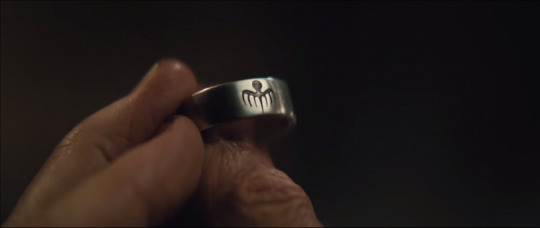
For more movie reviews, check out White-Glove Grindhouse!
#movie review#Spectre#James Bond#Skyfall#Quantum of Solace#Blofeld#Daniel Craig#Sam Mendes#007#white-glove grindhouse#wggh
1 note
·
View note
Text
REVIEW: “Detective Heart of America: The Final Freedom” (2015)

By Erik of White-Glove Grindhouse
If Jason Steele’s name sounds familiar, you might be a fan of his YouTube videos without even knowing it. FilmCow, Steele’s production company, has been putting out live-action and animated shorts for the web for over a decade, but now one of his popular shorts has been expanded to a full feature. No, it’s not Charlie the Unicorn or the endlessly quotable Llamas with Hats; a somewhat lesser-known FilmCow character named Detective Heart of America was the first to make this leap. But, the question remains: can a silly internet video really sustain its charm and comedic momentum over the course of an hour and fifteen minutes?
Detective Heart of America: The Final Freedom follows its titular detective (who just happens to be a statue of a bald eagle) on his most dire case yet: the end of America itself! Along the way, he runs into old enemies, such as a Pinocchio marionette he’d previously shot in the face, and new allies including Brendan, the only remaining member of a lost civilization. He runs afoul of the online currency known as Bitcoin, a pack of floating aliens who vaporize whatever they touch, and Jesus, who just happens to be a merman.

While it’s tempting to go further into the plot, part of what makes the film so much fun is that each moment delves into a new and unpredictable facet of Steele’s imagination. The course of events is incredibly silly, but never feels forced or obnoxious. Steele’s deadpan delivery of this ridiculous material (he voices most of the film’s menagerie of puppet characters) creates a world-weary quality that contrasts nicely with the bizarre twists and turns, which unfurl in the style of the weirdest film noir ever made.
Though he might not have as many videos to his name on YouTube as some of the other FilmCow creations, Detective Heart of America actually does quite well when it comes to carrying a movie on his own. In some ways, the character is a parody of pro-American rah-rah jingoism, but that stereotype isn’t used to make a political point so much as to mine the comedic value of the character’s ineptness. Frequently admitting that he has no clue what’s going on, Heart of America makes for a hero that’s both relatable and ridiculous.

I can only assume Steele has become an expert at hunting for strange-looking dolls and puppets, because the ones he makes use of in this film are hilariously weird. There’s a rabbit-woman named Goreslax, there’s Madison Square Garden (a zebra whose legs are frozen in a sitting position)... all of them seemingly rescued from the part of the thrift store even the employees are a little wigged out by. What’s even more impressive is how much personality and character these immobile statues take on, both through the voices they’re given and the way they’re manipulated by clearly-visible puppeteers’ hands. Purposely clunky, this style of non-animation makes the film feel charmingly handmade and one-of-a-kind.
Detective Heart of America: The Final Freedom could not have come from anybody but Jason Steele. His personal style might not connect with all viewers, but those who already enjoy his work will find the same unique humor in full force here. Thankfully, those unfamiliar with Steele’s work will lose nothing but their time by giving the film a shot, because he has posted the entire movie on YouTube for free. If you’ve read this far and find yourself curious, give it a shot. Not only is Detective Heart of America a successful adaptation of Steele’s video series, it’s an inspired and relentlessly silly movie that’s sure to delight those with a taste for offbeat comedy.
Final Score: 8/10

For more movie reviews, check out White-Glove Grindhouse!
#detective heart of america#filmcow#jason steele#charlie the unicorn#llamas with hats#the final freedom#pinocchio#stupid baby#goreslax#reggie
21 notes
·
View notes
Text
REVIEW: “In a World...” (2014)

By Erik Nikander of White-Glove Grindhouse
A first feature film is unquestionably significant. It’s the first major artistic statement of a new writer or director (sometimes both) that should provide a glimpse at the newcomer’s unique voice. It’s puzzling, then, that after seeing In a World… I don’t quite know how to react to Lake Bell, the film’s writer, director, and star. Say what you will about Trainwreck, but everyone who saw that knew immediately that Amy Schumer was the new “bad girl” of comedy, with an undercurrent of down-to-earth relatability. Despite featuring several strong performances and a unique premise, In a World… is too bogged down with the standard indie dramedy trappings to let its strengths take center stage.
In a World… is perhaps a first for films about the movie industry, as it focuses on the world of movie trailer voice-overs. Carol Solomon (Bell) is a struggling freelance vocal coach looking to break into trailer work. The fact that she’s a woman is a detriment in this regard, because the field is dominated by booming male voices, one of which is her father’s (Fred Melamed). But when word spreads that the studio might want a woman’s voice-over to advertise the film version of the female-dominated literary phenomenon The Amazon Games (in case you really didn’t know what they were alluding to), Carol sees her chance to snag the job and change the industry for the better.

If that plot was the entire focus of the film, that would be fine. Around the middle, however, the focus shifts to a strangely irrelevant romantic subplot centered on Carol’s sister Dani (Michaela Watkins) and her husband Moe (Rob Corddry). Will they cheat on each other? Will they reconcile just when all seems lost? When did I start watching a different movie? The whole subplot clashes with the voice-over industry segments, loading down a fresh, unique concept with predictable relationship drama. The method Carol uses to try to get the two back together is clever and somewhat inspired, but I couldn’t help but wonder why any of this mattered in the film as a whole.
Perhaps the time spent on that subplot could have been used to beef up the main conflict. As it is, Carol doesn’t work especially hard to land her voiceover gigs; they just sort of happen out of nowhere. The film sadly ignores what could be a hilarious takedown of stubborn adherence to gender traditions as Carol turns a male-dominated industry on its head. It’s not nearly as fun to watch what’s built up as a great sexist behemoth roll over for her to scratch its belly. Sure, we see Carol’s father complain about women taking jobs that “rightfully” belong to men, but individual prejudices and widespread, systematic discrimination are different beasts altogether. I wish In a World... had taken the time to demonstrate both in action.

The film also has some technical problems which don’t ruin the experience but are still noticeable and distracting. Most egregious is the fact that some shots seem a touch out of focus, something that it’s hard to imagine nobody noticed in the course of making the film. Though much of the dialogue isn’t bad per se, on the indie-quirkiness scale of “endearing” to “annoying” it sometimes veers a little too close to the latter. Much of the problem here comes from the character of Louis (Demetri Martin), whose awkward attempts to woo Carol come across as more cringe-inducing than cute. Fortunately, most of the characters, including Carol, remain grounded enough to avoid falling off the Precipice of Twee.
As much criticism as it deserves, In a World… isn’t a terrible film by any means. Its concept alone is intriguing enough to make it worth seeking out, as long as your expectations aren’t sky-high. Lake Bell is a strong performer who could easily carry a feature film, just preferably one that takes more chances and goes further with its material than this one does. If she works to improve her best creative qualities and keeps an eye on her weaknesses, her next film might resonate as deeply as the voices that engage the minds of movie audiences everywhere.
Final Score: 6 out of 10

#In a world#Lake Bell#comedy#indie#fred melamed#voice acting#voiceover#movie trailers#film review#movie review#trainwreck#amy schumer
3 notes
·
View notes